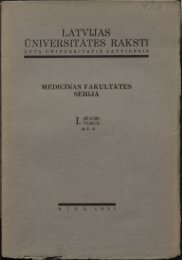ornamental sign language in the first order tracery belts - DSpace
ornamental sign language in the first order tracery belts - DSpace
ornamental sign language in the first order tracery belts - DSpace
You also want an ePaper? Increase the reach of your titles
YUMPU automatically turns print PDFs into web optimized ePapers that Google loves.
Tenisons, M; Zeps, D. Ornamental Sign Language In The First Order Tracery Belts<br />
Pict. 9. Chang<strong>in</strong>g colors <strong>in</strong> an <strong>ornamental</strong> <strong>tracery</strong> we get ano<strong>the</strong>r one. However this change does not effect to<br />
<strong>the</strong> same extent than by sieve displacement: we may discern previous <strong>ornamental</strong> <strong>tracery</strong> by our imag<strong>in</strong>ation.<br />
Pictures 9 and 10 show that sieve displacement and color <strong>in</strong>terchange work <strong>in</strong> different way<br />
<strong>in</strong> ornament build<strong>in</strong>g.<br />
Actually we could <strong>in</strong>troduce one more feasibility to double number of codes of <strong>sign</strong>s, scilicet,<br />
<strong>in</strong> place of asymmetric code allow<strong>in</strong>g to be its dual element, namely, asymmetric<br />
element with five units. But this would lead to some disbalance of colors or brightness of<br />
colors <strong>in</strong> <strong>ornamental</strong> <strong>tracery</strong>, scilicet, 5-unit elements would give more colored <strong>tracery</strong> that<br />
4-unit elements and com<strong>in</strong>g <strong>the</strong>m alternately would give place to disbalance of brightness of<br />
ornament. Thus, here we see where pure ma<strong>the</strong>matical argument may come <strong>in</strong> conflict with<br />
some artistic pr<strong>in</strong>ciple and human prehension: ma<strong>the</strong>matics would say that we may have<br />
<strong>sign</strong> codes whereas artistic pr<strong>in</strong>ciples would force us to restra<strong>in</strong> only to <strong>sign</strong> codes.<br />
The pr<strong>in</strong>ciple of <strong>the</strong> open<strong>in</strong>g of field <strong>in</strong>formation<br />
Modris Tenisons came to build<strong>in</strong>g ornament <strong>sign</strong>s <strong>in</strong> a little different way, namely, us<strong>in</strong>g<br />
pr<strong>in</strong>ciple of <strong>the</strong> open<strong>in</strong>g of field of <strong>in</strong>formation. Let us try to consider his approach, us<strong>in</strong>g<br />
some systematic argument.<br />
Let us <strong>first</strong> consider a little different proof to <strong>the</strong> <strong>the</strong>orem 3. Let us consider pict.8a on <strong>the</strong> left<br />
where we use two orthogonal reflections of elements, gett<strong>in</strong>g <strong>in</strong> this way ways of<br />
build<strong>in</strong>g a code of <strong>sign</strong>. Similarly let us do rotation of element accord<strong>in</strong>g <strong>the</strong> schema <strong>in</strong><br />
pict.8a on right: we do rotation of each corner gett<strong>in</strong>g codes of <strong>sign</strong>s. Two <strong>sign</strong>s are to be<br />
excluded to escape repetitions. Toge<strong>the</strong>r we get schemata that for asymmetric<br />
elements would give different codes of <strong>sign</strong>s. In this way we didn’t even use <strong>the</strong><br />
def<strong>in</strong>ition 2. Why? It turns out that <strong>the</strong> performance of rotation only <strong>in</strong> one direction is<br />
equivalent with <strong>the</strong> use of <strong>the</strong> def<strong>in</strong>ition 2 that <strong>in</strong>troduces equivalence of left and right sides<br />
of <strong>ornamental</strong> <strong>tracery</strong>. Allow<strong>in</strong>g rotations <strong>in</strong> both directions would result <strong>in</strong> gett<strong>in</strong>g<br />
repetitions of code that <strong>the</strong> def<strong>in</strong>ition 2 excludes.<br />
Pict.9. An example of <strong>the</strong> build<strong>in</strong>g of <strong>the</strong> code of <strong>sign</strong>. On <strong>the</strong> left one asymmetric element gives four codes of<br />
<strong>sign</strong>, correspond<strong>in</strong>gly <strong>in</strong> each corner, with asymmetric element <strong>in</strong> <strong>the</strong> center. In <strong>the</strong> picture <strong>in</strong> center and on <strong>the</strong><br />
9


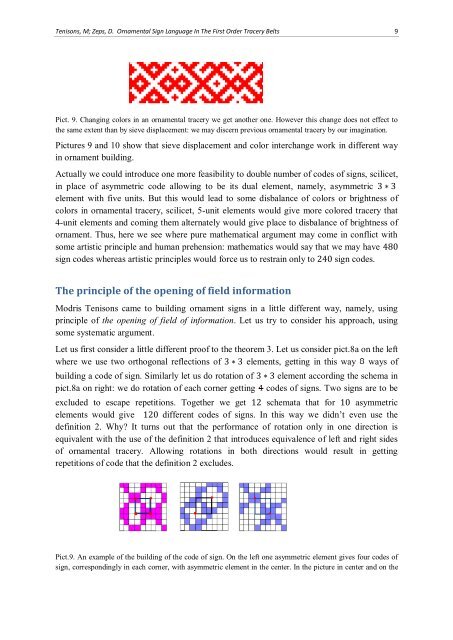
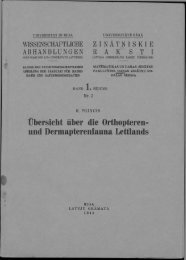
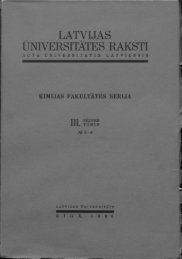
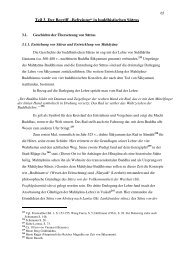
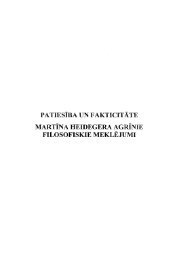
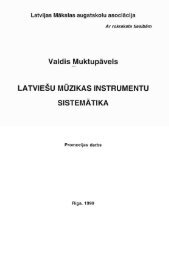
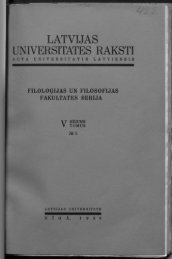
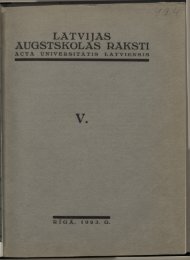


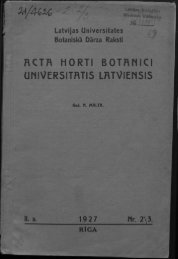
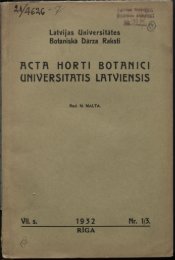
![LATVIJAS] - DSpace](https://img.yumpu.com/11778577/1/190x249/latvijas-dspace.jpg?quality=85)
